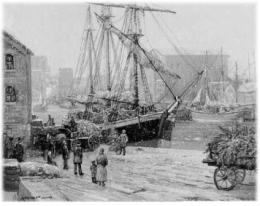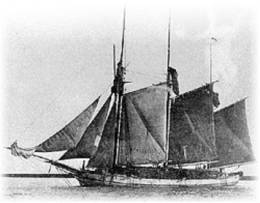The Way it Was: The Christmas Tree Ship
In early December the Coast Guard Cutter Mackinaw brought a load of Christmas Trees to Chicago from Cheyboygan, a trip it has made the past three years. By stacking them high on the deck the crew was able to load 500 trees for needy families--a far cry from the over 5,000 attempted in 1912 by the Rouse Simmons, remembered today as the Christmas Tree Ship. Of course the Rouse Simmons didn't make it to port.
 In the late 1800s the wooden schooners that had played such an important role in Great Lakes commerce were being phased out, and could be picked up cheap. The Schuenemann brothers, August and Herman, both captains, came up with a novel use at the end of the season: delivering Christmas trees from Michigan's Upper Peninsula to Chicago, where they were sold right off the ship. August initiated this in 1890, and was known as Christmas Tree Schuenemann until his schooner, the S. Thal, sank with all hands in 1893. In the late 1800s the wooden schooners that had played such an important role in Great Lakes commerce were being phased out, and could be picked up cheap. The Schuenemann brothers, August and Herman, both captains, came up with a novel use at the end of the season: delivering Christmas trees from Michigan's Upper Peninsula to Chicago, where they were sold right off the ship. August initiated this in 1890, and was known as Christmas Tree Schuenemann until his schooner, the S. Thal, sank with all hands in 1893.
The loss of his brother didn't stop Herman from making the same run with a variety of ships, starting in 1894. In 1910 he was able to acquire an eighth interest in the Rouse Simmons, along with the Beaver Hotel's Mannes Bonner, who used her for delivering tan back from Iron Ore Bay to Boyne City, and Charles Nelson. Under Herman's control the ship became a vagabond, wandering around the lake looking for work until it was time to pick up a load of Christmas Trees from Thompson, ten miles west of Manistique. Logging had run its course, and the loggers looked forward to making a little Christmas money by delivering spruce and balsam saplings to Harman's ship.
The Rouse Simmons was an old (she'd been built in 1868, 125' long with a 28' beam) ship and not in good shape, although she had just been caulked. The previous year she'd had to be rescued by the car ferry, Grand Haven, and as the weather worsened in the fall of 1912 talk around the port was that she was nearing the end. A rumor started that the rats had abandoned her when she started up the lake from Chicago, causing at least one sailor Herman counted on for the 300-mile return trip to jump ship. But Captain Herman was brimming with self-confidence as he strode the dock: he had sailed her successfully time after time, and he had no doubt he would do so again.
Because the weather was closing down and a second trip was unlikely, Herman took on more trees than was his custom. They filled the hold and were lashed fifteen feet high on the deck; the lower booms had to be propped up on wooden crutches to make them useable. On the 22nd of November a tug pulled her out of the harbor, and she set off into the windy greyness. The temperature quickly dropped below freezing, and a heavy snow began to fall, but Captain Herman did not waver. He chose the open water as less risky than hugging the shore, and assured the fifteen men on board that he would have them safe and sound at the Clerk Street pier.
 When the ship was sighted by the Kenosha Life Savers the next day, her torn sails were caked with ice and she was flying distress signals. All they had was a rowed boat, so they phoned the nearby Two Rivers station and alerted them that the troubled ship was approaching. The Two Rivers crew had a 34- power boat, the Tuscadora, which they launched in the hope to be of help. The snow was coming in squalls: one minute they could see for a mile, but the next only a hundred feet. They pushed forward into the gale, suddenly catching sight of the Christmas Tree Ship only ¼ mile away. Her sails were tattered, and the trees still tied to the deck had become thickets of ice. As she bucked and floundered through the waves it was apparent the ice-bound cargo had made her top-heavy. All the fourteen men could do (two had already been washed overboard, along with their only small boat) was lash themselves together, and pray. Yet they were only a thousand feet away from the Tuscadora, so there was hope. But then the white curtain descended again, cutting off all vision. When it lifted a short time later, the Tuscadora was all alone on the sea. When the ship was sighted by the Kenosha Life Savers the next day, her torn sails were caked with ice and she was flying distress signals. All they had was a rowed boat, so they phoned the nearby Two Rivers station and alerted them that the troubled ship was approaching. The Two Rivers crew had a 34- power boat, the Tuscadora, which they launched in the hope to be of help. The snow was coming in squalls: one minute they could see for a mile, but the next only a hundred feet. They pushed forward into the gale, suddenly catching sight of the Christmas Tree Ship only ¼ mile away. Her sails were tattered, and the trees still tied to the deck had become thickets of ice. As she bucked and floundered through the waves it was apparent the ice-bound cargo had made her top-heavy. All the fourteen men could do (two had already been washed overboard, along with their only small boat) was lash themselves together, and pray. Yet they were only a thousand feet away from the Tuscadora, so there was hope. But then the white curtain descended again, cutting off all vision. When it lifted a short time later, the Tuscadora was all alone on the sea.
In Chicago, 1912 became the year without sufficient Christmas trees.
The next year Herman's widow returned to the Christmas Tree business, along with her three daughters, but instead of chartering a ship to bring them she had them hauled down on the train. But she was enterprising enough to lease an old wreck tied up at the Clark Street dock and load the trees on. For the Schuenemanns, it was business as usual, even so far as the daughters setting up their customary side-line of making wreaths from broken branches right on the ship. They continued to trade on their early fame for another 21 years. In the meantime, every year when the fishermen near Two Rivers pulled up their nets, they were likely to find that their biggest catch was a sadly rotted, unornamented Christmas tree.
No one knew for sure where the sunken ship lay, but in 1971 Milwaukee scuba diver Kent Bellrichard borrowed some sonar equipment to search for the wreck of the Vernon, which had gone down in 1887 in that area (see the Journal of Beaver Island History, V5.) By accident he discovered the remains of the Rouse Simmons, her hold still full of decayed Christmas trees. He hauled up her huge anchor, which today sits at the Milwaukee Yacht Club, and a few other mementos. Other finds included a skull, a message in a bottle (found in 1927), and Captain Schuenemann's wallet, still held together with a rubber band eleven years after his death.
The Christmas Tree Ship was clearly doomed the moment she left port and her seams began to open from the pressure of the sea, yet she had once been a fine boat. When Tim Graul was preparing to design the Dennis Sullivan (which appeared in our harbor this past July), and wanted to give her the clean lines of a fast schooner, one of the ships whose plans he studied was the Rouse Simmons. Barry, how about a song?
The Real Beacon:
Search the Beaver Beacon Web Site & Archive:
|
